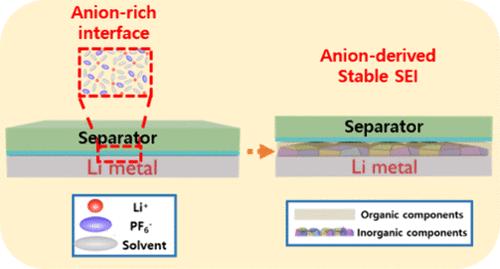利用自组装单层制备长寿命锂金属电池的富阴离子界面
IF 8.2
2区 材料科学
Q1 MATERIALS SCIENCE, MULTIDISCIPLINARY
引用次数: 0
摘要
由于锂金属具有极高的能量密度,锂金属电池被认为是下一代储能系统最有前途的候选者之一。然而,界面问题,特别是不稳定的固体电解质界面(SEI)和锂枝晶生长,阻碍了实际应用。本文通过在陶瓷涂层隔膜上引入带正电荷的自组装单层膜(sam),在Li金属附近诱导出一个富含阴离子的界面,同时稳定SEI和均匀Li沉积。由SAMs静电吸引产生的富阴离子界面,促进了盐阴离子对有机溶剂分子的优先分解,从而形成了稳定的阴离子衍生的无机组分,特别是LiF。此外,带正电荷的sam固定阴离子,通过提高Li+转移数(~ 0.73)显著减轻枝晶Li,从而减缓枝晶Li的生长。因此,我们提出了陶瓷涂层隔膜上的sam,作为改善锂金属电池长期循环性能的创新方法。本文章由计算机程序翻译,如有差异,请以英文原文为准。

Anion-Rich Interface via a Self-Assembled Monolayer toward a Long-Lifespan Li Metal Battery
Due to the extremely high energy density of Li metal, Li metal batteries are regarded as one of the most promising candidates for next-generation energy storage systems. However, interfacial issues, particularly the unstable solid electrolyte interphase (SEI) and lithium dendritic growth, hinder practical application. Herein, we induce an anion-rich interface near the Li metal by introducing positively charged self-assembled monolayers (SAMs) on ceramic-coated separators to simultaneously stabilize the SEI and homogenize the Li deposition. The anion-rich interface, originating from the electrostatic attraction of SAMs, promotes the preferential decomposition of salt anions over organic solvent molecules, leading to the formation of a stable anion-derived inorganic component, notably LiF. Furthermore, the positively charged SAMs immobilize anions, significantly mitigating dendritic Li by improving the Li+ transference number (∼0.73) and thereby mitigating dendritic Li growth. Hence, we present SAMs on ceramic-coated separators as an innovative way to improve the long-term cycling performance of Li metal batteries.
求助全文
通过发布文献求助,成功后即可免费获取论文全文。
去求助
来源期刊

ACS Applied Materials & Interfaces
工程技术-材料科学:综合
CiteScore
16.00
自引率
6.30%
发文量
4978
审稿时长
1.8 months
期刊介绍:
ACS Applied Materials & Interfaces is a leading interdisciplinary journal that brings together chemists, engineers, physicists, and biologists to explore the development and utilization of newly-discovered materials and interfacial processes for specific applications. Our journal has experienced remarkable growth since its establishment in 2009, both in terms of the number of articles published and the impact of the research showcased. We are proud to foster a truly global community, with the majority of published articles originating from outside the United States, reflecting the rapid growth of applied research worldwide.
 求助内容:
求助内容: 应助结果提醒方式:
应助结果提醒方式:


